Top 10 Best Electric Cars in India in 2023
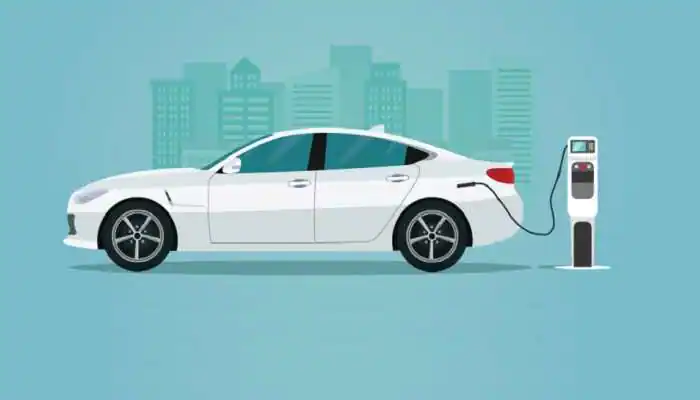
Top 10 Best Electric Cars in India in 2023
The market for electric vehicles (EVs) is quickly globally. According to EV volumes, the total number of electric vehicles (including battery electric vehicles [BEVs] and Plug-in hybrid electric vehicles [PHEVs]) on the road increased from 4.2% in 2020 to 8.3% in 2021, with 6.75 million vehicles.
As of 2020, this represents an increase of 108%. As they contribute to lowering emissions and the depletion of natural resources, EVs are gaining popularity around the world. Since close to 0.32 million vehicles were sold in 2021, an increase of 168% YoY, the Indian EV sector is developing quickly. The Paris Agreement aims to reduce carbon emissions, improve air quality in urban areas, and decrease oil imports, which is the foundation for India’s ongoing adoption of electric vehicles.
By 2030, the Indian automobile sector, which ranks fifth globally, is projected to overtake the United States as the largest. According to the India Energy Storage Alliance, the Indian EV market would grow at a CAGR of 36% because India imports about 80% of its oil needs, and dependency on conventional energy sources is not a viable choice as population growth and car demand increase. By 2030, NITI Aayog wants to see EV sales penetration for all commercial vehicles reach 70%, for private vehicles to reach 30%, for buses to reach 40%, and for two- and three-wheelers to reach 80%. The aim of achieving net zero carbon emissions by 2070 is consistent with this.
According to the Ministry of Heavy Industries, 0.52 million EVs have been registered in India over the last three years. EVs experienced strong growth in 2021, which was aided by the government’s adoption of beneficial laws and initiatives.
Uttar Pradesh led all Indian states in the sale of electric vehicles in 2021, with 66,704 units sold across all categories, followed by Karnataka with 33,302 units and Tamil Nadu with 30,036 units. The three-wheeler market was controlled by Uttar Pradesh, while the two- and four-wheeler markets are led by Karnataka and Maharashtra.
People are looking for alternate sources to save their monthly expenses, and the Indian EV industry is gaining steam thanks to government initiatives and the rise in oil costs. However, a widespread switch from internal combustion engine (ICE) vehicles to electric vehicles (EVs) necessitates the expansion of infrastructure facilities, like charging stations and automobiles, with a greater range. To reach the aim of 100% EV use by 2030, the government has launched many measures to increase EV manufacturing and adoption across the nation.
Following are the Top 10 best electric cars in India in 2023
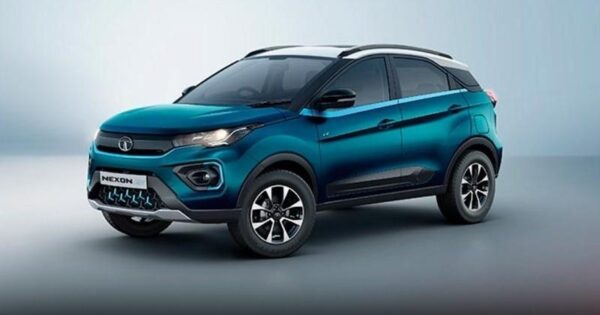
1. Tata Nexon EV
In January 2020, the Nexon EV, the electric variant of the Nexon, was released in the nation. Three variations of the small electric SUV are provided: the XM, the XZ+, and the XZ+ LUX. Three colour options are available to interested customers: Signature Teal Blue, Glacier White, and Moonlit Silver. For the Nexon EV, Tata Motors provides a basic warranty of three years/1.25 lakh kilometres and an eight-year/1.6 lakh kilometres battery and motor guarantee.
Exterior: Impact Design 2.0 is the framework on which the Nexon EV is built. The stylish grille with recognisable tri-arrow components at the bottom of the bumper draws attention to the fascia. Between the headlamps, the Humanity Line is tough to miss. The more expensive model has a sunroof and rain-sensing front wipers. Additionally, it receives a new set of alloy wheels to distinguish it from the standard model.
Interior: A basic instrument panel that shows information about the charge level, driving range, battery consumption, turn-by-turn navigation, and other items is included with the Nexon EV, along with a flat-bottom steering wheel made by Altroz. A seven-inch touchscreen infotainment system and controlled climate control are further features. The Nexon EV received a five-star safety certification in GNCAP crash tests, making it the safest electric SUV made in India. As standard safety equipment, cornering stability control, ABS with EBD and dual airbags are provided.
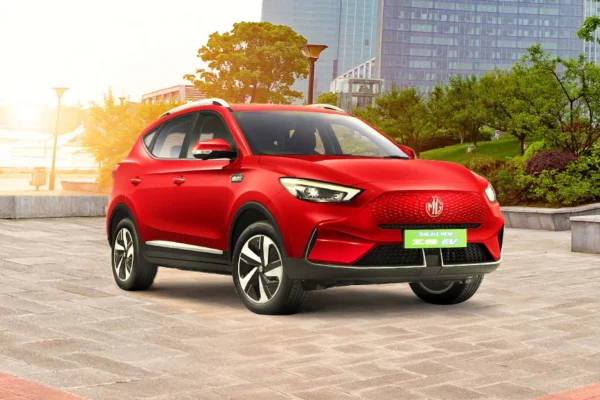
2. MG ZS EV
In March 2022, the all-electric MG ZS facelift from the British automaker MG was introduced in India. Now, it has a bigger battery pack and a longer range. The ZS EV has two trims—Excite and Exclusive—and four exterior colours.
Exterior: The new ZS EV has 17-inch revised wheels, new LED headlights with integrated L-shaped DRLs, new L-shaped rear lights, different front and back bumpers, and a panoramic sunroof.
Interior: Except for a new, larger 10.1-inch infotainment touchscreen with i-Smart linked car technologies and a seven-inch digital instrument cluster, the inside of the ZS EV is unaltered. A 360-degree video system, a wireless charging pad, power-adjustable front seats, blind-spot detection, lane change assistance, rear-cross traffic alert, six airbags, cruise control, an electric parking brake, and wipers are other features.
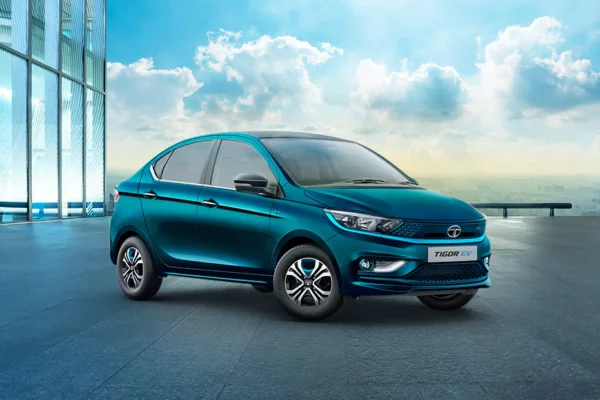
3. Tata Tigor EV
The Tata Tigor EV is now the brand’s second-most cheap EV option, after the Nexon EV. It was the first electric car to undergo a Global NCAP safety test and receive a commendable four-star rating.
Exterior: The Tigor EV is identical to the Tigor with an internal combustion engine in terms of appearance. Revised daytime running lamps, a new grille, and the “Humanity line” being painted in the company’s signature blue have all been added to this all-electric sedan’s exterior. The front end of the Tigor EV has been improved, and new wheels that resemble alloys are included. Dual-tone paint and a black contrast top are options for the Tata EV.
Interior: The Tigor EV’s dark interior features a grey and black colour scheme. The chairs are decorated with a tri-arrow motif in a striking blue colour. There are recognisable blue highlights on the centre console, instrument cluster, and air conditioning vents. Tata includes a flat-bottom steering wheel, an engine start/stop lever, a digital instrument cluster, and a seven-inch Harman infotainment touchscreen with more than 30 connected car capabilities.
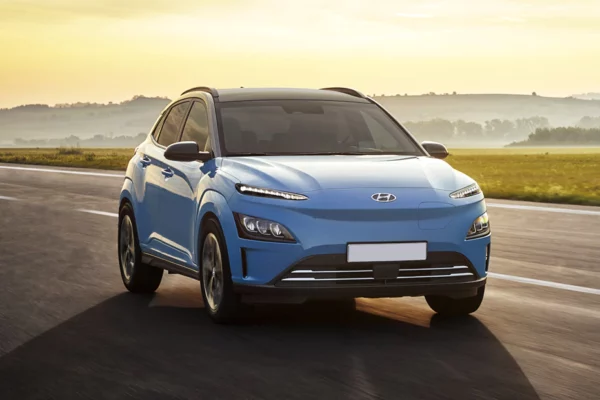
4. Hyundai Kona Electric
The Hyundai Kona electric was imported into the nation through the CKD route and is provided in five different colour variations in addition to one top-of-the-line model. Additionally available is a dual-colour option for the electric SUV.
Exterior: Dynamic roof rails, a built-in rear spoiler, LED DRLs, cornering lamps, 17-inch alloy wheels, and ORVMs with built-in turn indicators are all features of the new Hyundai Kona EV.
Interior: The model includes an infotainment system with a 7-inch touchscreen that supports Apple CarPlay, Android Auto, Bluetooth connectivity, and voice recognition, and all-black interiors, leather seats, a leather-wrapped steering wheel, an electric sunroof, and cruise control.
The Kona EV can travel 452 km on a single charge thanks to a 39.2 kWh battery pack. A 100 kW DC fast charger can charge the battery to 80 per cent in just 57 minutes, while a regular AC charger can charge the Kona to 100% in 6 hours and 10 minutes. This battery pack produces 136 PS of power and 395 Nm of torque. With these figures, the automobile can reach 100 km/h in 9.7 seconds.
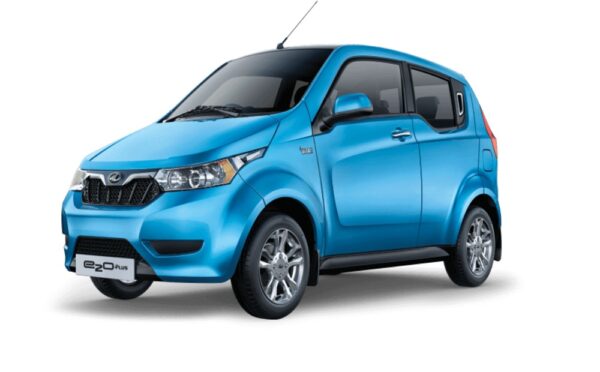
5. Mahindra e2oPlus
The Mahindra e2o Plus, India’s well-known electric hatchback, has consistently been a competitive participant in its market. The four-door pure electric hatchback comes in four variations: P2, P4, P6, and P8. The P2 trim is intended for the commercial market, the P4 is the least expensive version that customers can purchase, and the P8 is the top-of-the-line trim with the most features.
Exterior: The new e2o Plus has a steel frame structure, a redesigned grille, a revamped rear end, and Mahindra’s recognisable vertical design to set it apart from its predecessor. The e2o provides alloy wheels and a reverse parking camera, depending on the model. The electric car has a 2258mm wheelbase and a 170mm ground clearance.
Interior: The e2o Plus has fabric and vinyl seat cover options, a Blaupunkt infotainment system, air conditioning, power windows, a remote lock with keyless entry, and remote hatch actuation, depending on the variation selected. A spare tyre with a lamp inside is located under the hood of the e2o Plus. On the centre stack, the cabin receives a cubic printing. It’s interesting to note that all variations have similar instrument consoles and charging ports.
Engine: The e2o Plus’ electric motor comes in two tunings: 25 bhp/70 Nm and 40 bhp/91 Nm. Depending on the model, the e2o Plus can reach a top speed of up to 85kmph and cover up to 140km on a single charge. With 23 modules and 69 cells as opposed to 16 and 48 in the other models, the P8 receives the same but heavier lithium ion 210Ah battery. In contrast to the other vehicles’ 110km of driving range, the P8 has a 140km driving range.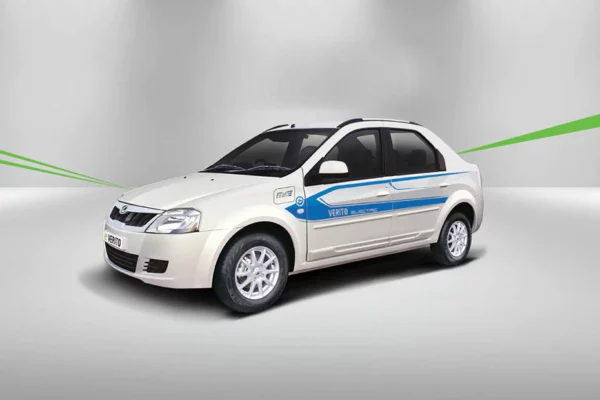
6. Mahindra e-Verito
Verito Vibe is praised for its comfort and performance-packed design. It is one of the automobiles that has contributed to Mahindra’s success. This car has captured the hearts of many with its tough appearance and powerful performance. It is a great purchase at this affordable price because of its effective suspension and trustworthy braking systems. Its USPs include high safety, spacious interiors, and low maintenance costs.
Exterior: Starting with the exterior, the car has many enticing characteristics that make it stand out and seem fashionable. The broad and elegant grille on the front fascia is a very appealing feature, and the base and centre trim are combined with matte black tops and bottom bezels.
On the other hand, the top model has a front grille made of shiny carbon. The front windscreen is equipped with a washer and two 2-speed option wipers for clear visibility. The front and rear bumpers are painted in the same body colour to give the car a unified appearance. Top versions come with side mouldings that are painted in the body colour.
Only the mid-level and top models are designed with exterior door handles and wing mirrors in body colour. High-mount stop lamps on the windscreen of this type are fitted to improve the rear aesthetics. The front bumper of the high-end trims is fastened with fog lights that have clear lenses.
Interior: The Mahindra Verito Vibe has many elegant and appealing interior features. These contain different comfort-focused and utility-based features for the greater convenience of travellers. The seats have thick cushions and are upholstered in woven jacquard fabric. Sporty and black colorgear knobs are used on the entry-level and midrange models. On the other hand, the top model has a silver gear shift lever knob.
The dashboard, which has a lot of storage space, has the instrument panel and a centre console. In the most expensive models, a bottle holder is available. All versions of this car come with sun visors for the driver’s seat and the passenger seat. 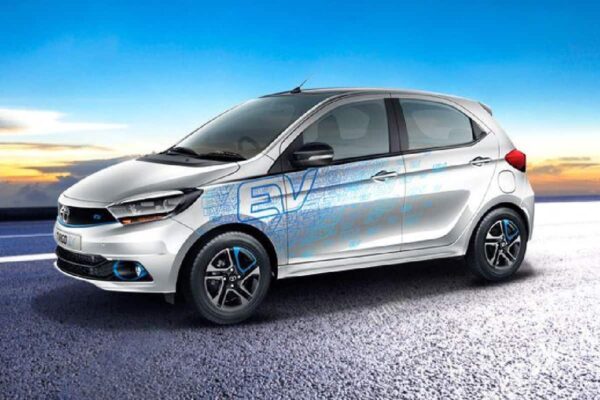
7. Tata Tiago EV
The Tiago, a popular option in its market and a major contributor to Tata’s overall sales in India, is the company’s entry-level offering. Tata Motors first unveiled the upgraded Tiago in the nation in January 2020, adding several new features and visual improvements. The hatchback comes in many models, including the XE, XT, XZ, XTA, XZ Plus, XZA, and XZA Plus. The XZ Plus and XZA Plus models come in dual-tone colour options.
Exterior: The redesigned model has a new grille, a chrome strip, a modified bumper with air dams and circular fog lamps, dual-tone alloy wheels in higher trim levels, and black highlights to set it from its predecessor. The car’s familiar design aspects have mostly been kept, except for minor updates for newness.
Interior: Compared to its predecessor, the inside only receives minor modifications. A touchscreen infotainment system with Apple Carplay and Android Auto is one of the obvious modifications. Dual airbags, ABS, EBD, rear parking sensors, a seatbelt reminder, and a high-speed alert system are some of the safety features that come as standard.
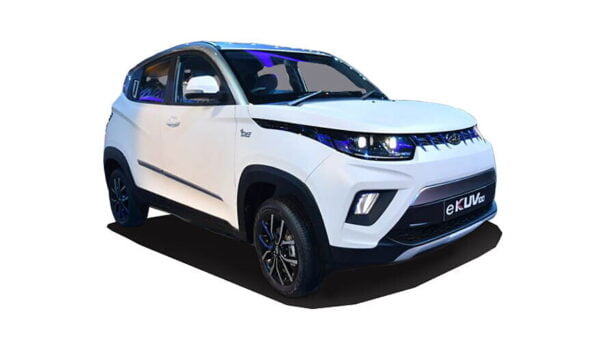
8. Mahindra e-KUV100
The eKUV100 was on display by Mahindra at the 2018 Auto Expo. The electric KUV100 will lead the Indian automaker’s electric car lineup. When the eKUV is introduced in the nation, Mahindra Electric, the Indian automaker’s electric vertical, will be in charge of its development. Although the prices haven’t been disclosed yet, anticipate them to be slightly pricier than the electric Verito.
With the exception of the badging, the eKUV100 resembles a conventional automobile in terms of appearance. The electric KUV does without a gear lever, although the situation is the same on the inside. The gear lever no longer hampers the six-seat configuration.
Mahindra promises that the new eKUV has improved connectivity features, including real-time position tracking, cabin pre-cooling, and remote diagnostics. The electric compact crossover might monitor even the battery level and the driver’s driving style.
The same 30kW lithium-ion battery pack that powers the eVerito would power the eKUV. With a rapid charging capability, which can charge to 80% in about an hour, the car can go 140 kilometres on a full charge. When the car is released, a brand-new powerplant may be available.
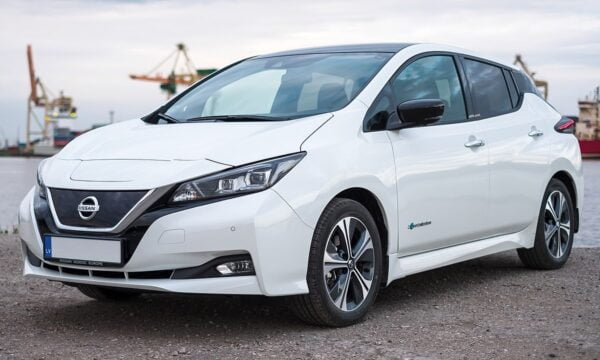
9. Nissan Leaf
The Nissan Leaf has been observed many times in the Indian market, but no official date for its release has been set. With the release of the Leaf, Nissan Indian will make a major entry into the EV market. The company already sells Magnite, Kicks, and GTR.
Battery Specs: The Lead is powered by a 40kWh battery pack with a 146 horsepower maximum output and 320 Nm maximum torque. A smaller 3kW charger that charges the battery in 16 hours and a larger 6kW charger that charges the battery in 8 hours are both included with the Nissan Leaf.
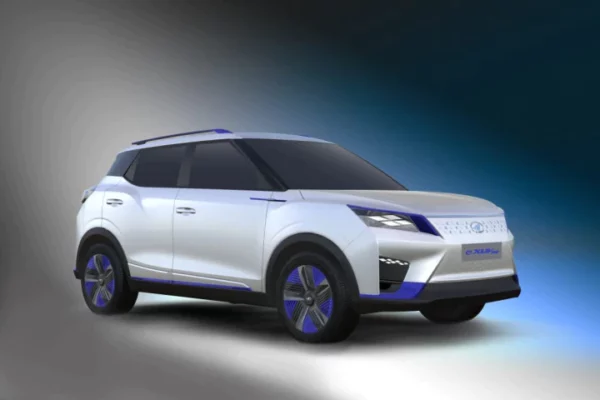
10. Mahindra XUV300 EV
With a target release date of January 2023, the first high-voltage Mahindra SUV is anticipated to be unveiled sooner, maybe in the second part of this year.
Sources claim that the production model of the electric XUV300 might use the XUV400 moniker, which they had earlier reported. The creator predicts that the ICE XUV300 and its EV variant will differ enough to merit a new name. Aside from the powertrain, the length is the main difference between the versions.
The electric variant, according to Mahindra, “will be 4.2 metres long,” which is a full 200 millimetres more than the present XUV300, which must be under 4 metres in length to be eligible for tax advantages. Given that EVs already enjoy lower taxes and are not penalised for length, unlike ICE vehicles, Mahindra will use the longer SsangYong Tivoli’s body structure to expand the XUV300’s trunk space, which is now relatively little.
Battery is the key
But it guarantees that the single motor powering the front wheels will have a minimum of 150 horsepower and run on high-density NMC pouch cells. There are no details on the powertrain or batteries. In terms of power, this would put the electric XUV300 slightly ahead of the recently announced Tata Nexon EV Max, which generates 143hp. The use of high-density NMC cells accounts for the electric XUV300’s greater range when compared to the Nexon EV Max, which uses cylindrical LFP cells with lower power densities.
Mahindra will have to overcome a major obstacle to guarantee a steady supply of batteries for the XUV400, which LG Chem will supply. The South Korean battery manufacturer’s inability to scale up numbers for the batteries explicitly made for the XUV400 is one of the key reasons for the launch’s delay. Mahindra showcased an electric XUV300 concept at the 2020 Auto Expo, almost three years before the final production car will be made available.
edited and proofread by nikita sharma




